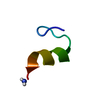[English] 日本語
 Yorodumi
Yorodumi- EMDB-70121: Cryo-EM structure of the human SK2-4 chimera/calmodulin channel c... -
+ Open data
Open data
- Basic information
Basic information
| Entry |  | |||||||||
|---|---|---|---|---|---|---|---|---|---|---|
| Title | Cryo-EM structure of the human SK2-4 chimera/calmodulin channel complex bound to the bee toxin apamin | |||||||||
 Map data Map data | Unsharpened map | |||||||||
 Sample Sample |
| |||||||||
 Keywords Keywords | Ion channel / Toxin / Apamin / Potassium / TRANSPORT PROTEIN-TOXIN complex | |||||||||
| Function / homology |  Function and homology information Function and homology informationnegative regulation of inward rectifier potassium channel activity / inward rectifier potassium channel inhibitor activity / venom-mediated perturbation of biological process / intermediate conductance calcium-activated potassium channel activity / saliva secretion / small conductance calcium-activated potassium channel activity / Acetylcholine inhibits contraction of outer hair cells / negative regulation of potassium ion transmembrane transporter activity / membrane repolarization during atrial cardiac muscle cell action potential / Ca2+ activated K+ channels ...negative regulation of inward rectifier potassium channel activity / inward rectifier potassium channel inhibitor activity / venom-mediated perturbation of biological process / intermediate conductance calcium-activated potassium channel activity / saliva secretion / small conductance calcium-activated potassium channel activity / Acetylcholine inhibits contraction of outer hair cells / negative regulation of potassium ion transmembrane transporter activity / membrane repolarization during atrial cardiac muscle cell action potential / Ca2+ activated K+ channels / stabilization of membrane potential / negative regulation of potassium ion transmembrane transport / macropinocytosis / calcium-activated potassium channel activity / regulation of calcium ion import across plasma membrane / potassium channel inhibitor activity / inward rectifier potassium channel activity / positive regulation of potassium ion transmembrane transport / cell volume homeostasis / regulation of potassium ion transmembrane transport / CaM pathway / Cam-PDE 1 activation / Sodium/Calcium exchangers / Calmodulin induced events / Reduction of cytosolic Ca++ levels / Activation of Ca-permeable Kainate Receptor / CREB1 phosphorylation through the activation of CaMKII/CaMKK/CaMKIV cascasde / Loss of phosphorylation of MECP2 at T308 / phospholipid translocation / CREB1 phosphorylation through the activation of Adenylate Cyclase / CaMK IV-mediated phosphorylation of CREB / PKA activation / negative regulation of high voltage-gated calcium channel activity / Glycogen breakdown (glycogenolysis) / CLEC7A (Dectin-1) induces NFAT activation / Activation of RAC1 downstream of NMDARs / negative regulation of ryanodine-sensitive calcium-release channel activity / organelle localization by membrane tethering / mitochondrion-endoplasmic reticulum membrane tethering / autophagosome membrane docking / negative regulation of calcium ion export across plasma membrane / regulation of cardiac muscle cell action potential / presynaptic endocytosis / Synthesis of IP3 and IP4 in the cytosol / regulation of cell communication by electrical coupling involved in cardiac conduction / positive regulation of T cell receptor signaling pathway / Phase 0 - rapid depolarisation / calcineurin-mediated signaling / Negative regulation of NMDA receptor-mediated neuronal transmission / Unblocking of NMDA receptors, glutamate binding and activation / alpha-actinin binding / RHO GTPases activate PAKs / Uptake and function of anthrax toxins / Ion transport by P-type ATPases / regulation of ryanodine-sensitive calcium-release channel activity / Long-term potentiation / protein phosphatase activator activity / Calcineurin activates NFAT / Regulation of MECP2 expression and activity / DARPP-32 events / Smooth Muscle Contraction / immune system process / detection of calcium ion / regulation of cardiac muscle contraction / potassium channel activity / catalytic complex / RHO GTPases activate IQGAPs / regulation of cardiac muscle contraction by regulation of the release of sequestered calcium ion / cellular response to interferon-beta / calcium channel inhibitor activity / Protein methylation / Activation of AMPK downstream of NMDARs / presynaptic cytosol / regulation of release of sequestered calcium ion into cytosol by sarcoplasmic reticulum / Ion homeostasis / eNOS activation / titin binding / Tetrahydrobiopterin (BH4) synthesis, recycling, salvage and regulation / sperm midpiece / regulation of calcium-mediated signaling / voltage-gated potassium channel complex / potassium ion transmembrane transport / calcium channel complex / FCERI mediated Ca+2 mobilization / substantia nigra development / regulation of heart rate / Ras activation upon Ca2+ influx through NMDA receptor / FCGR3A-mediated IL10 synthesis / Antigen activates B Cell Receptor (BCR) leading to generation of second messengers / calyx of Held / adenylate cyclase activator activity / sarcomere / VEGFR2 mediated cell proliferation / protein serine/threonine kinase activator activity / VEGFR2 mediated vascular permeability / regulation of cytokinesis / positive regulation of protein secretion / spindle microtubule / Translocation of SLC2A4 (GLUT4) to the plasma membrane / positive regulation of receptor signaling pathway via JAK-STAT Similarity search - Function | |||||||||
| Biological species |  Homo sapiens (human) / Homo sapiens (human) /  | |||||||||
| Method | single particle reconstruction / cryo EM / Resolution: 3.18 Å | |||||||||
 Authors Authors | Cassell SJ / Khoshouei M / Wilhelm WA / Whicher JR | |||||||||
| Funding support | 1 items
| |||||||||
 Citation Citation |  Journal: To Be Published Journal: To Be PublishedTitle: Mechanism of SK2 channel gating and its modulation by the bee toxin apamin and small molecules Authors: Cassell SJ / Li W / Krautwald S / Khoshouei M / Lee YT / Hou J / Guan W / Peukert S / Wilhelm WA / Whicher JR | |||||||||
| History |
|
- Structure visualization
Structure visualization
| Supplemental images |
|---|
- Downloads & links
Downloads & links
-EMDB archive
| Map data |  emd_70121.map.gz emd_70121.map.gz | 168.1 MB |  EMDB map data format EMDB map data format | |
|---|---|---|---|---|
| Header (meta data) |  emd-70121-v30.xml emd-70121-v30.xml emd-70121.xml emd-70121.xml | 26.2 KB 26.2 KB | Display Display |  EMDB header EMDB header |
| FSC (resolution estimation) |  emd_70121_fsc.xml emd_70121_fsc.xml | 11.9 KB | Display |  FSC data file FSC data file |
| Images |  emd_70121.png emd_70121.png | 141.6 KB | ||
| Filedesc metadata |  emd-70121.cif.gz emd-70121.cif.gz | 7.4 KB | ||
| Others |  emd_70121_additional_1.map.gz emd_70121_additional_1.map.gz emd_70121_half_map_1.map.gz emd_70121_half_map_1.map.gz emd_70121_half_map_2.map.gz emd_70121_half_map_2.map.gz | 87.9 MB 165 MB 165 MB | ||
| Archive directory |  http://ftp.pdbj.org/pub/emdb/structures/EMD-70121 http://ftp.pdbj.org/pub/emdb/structures/EMD-70121 ftp://ftp.pdbj.org/pub/emdb/structures/EMD-70121 ftp://ftp.pdbj.org/pub/emdb/structures/EMD-70121 | HTTPS FTP |
-Related structure data
| Related structure data |  9o52MC  9o48C  9o51C  9o53C  9o5oC M: atomic model generated by this map C: citing same article ( |
|---|---|
| Similar structure data | Similarity search - Function & homology  F&H Search F&H Search |
- Links
Links
| EMDB pages |  EMDB (EBI/PDBe) / EMDB (EBI/PDBe) /  EMDataResource EMDataResource |
|---|---|
| Related items in Molecule of the Month |
- Map
Map
| File |  Download / File: emd_70121.map.gz / Format: CCP4 / Size: 178 MB / Type: IMAGE STORED AS FLOATING POINT NUMBER (4 BYTES) Download / File: emd_70121.map.gz / Format: CCP4 / Size: 178 MB / Type: IMAGE STORED AS FLOATING POINT NUMBER (4 BYTES) | ||||||||||||||||||||||||||||||||||||
|---|---|---|---|---|---|---|---|---|---|---|---|---|---|---|---|---|---|---|---|---|---|---|---|---|---|---|---|---|---|---|---|---|---|---|---|---|---|
| Annotation | Unsharpened map | ||||||||||||||||||||||||||||||||||||
| Projections & slices | Image control
Images are generated by Spider. | ||||||||||||||||||||||||||||||||||||
| Voxel size | X=Y=Z: 0.845 Å | ||||||||||||||||||||||||||||||||||||
| Density |
| ||||||||||||||||||||||||||||||||||||
| Symmetry | Space group: 1 | ||||||||||||||||||||||||||||||||||||
| Details | EMDB XML:
|
-Supplemental data
-Additional map: Unsharpened map
| File | emd_70121_additional_1.map | ||||||||||||
|---|---|---|---|---|---|---|---|---|---|---|---|---|---|
| Annotation | Unsharpened map | ||||||||||||
| Projections & Slices |
| ||||||||||||
| Density Histograms |
-Half map: Half Map A
| File | emd_70121_half_map_1.map | ||||||||||||
|---|---|---|---|---|---|---|---|---|---|---|---|---|---|
| Annotation | Half Map A | ||||||||||||
| Projections & Slices |
| ||||||||||||
| Density Histograms |
-Half map: Half Map B
| File | emd_70121_half_map_2.map | ||||||||||||
|---|---|---|---|---|---|---|---|---|---|---|---|---|---|
| Annotation | Half Map B | ||||||||||||
| Projections & Slices |
| ||||||||||||
| Density Histograms |
- Sample components
Sample components
-Entire : Ternary complex of human SK2-4 chimera/calmodulin channel complex...
| Entire | Name: Ternary complex of human SK2-4 chimera/calmodulin channel complex bound to the bee toxin apamin |
|---|---|
| Components |
|
-Supramolecule #1: Ternary complex of human SK2-4 chimera/calmodulin channel complex...
| Supramolecule | Name: Ternary complex of human SK2-4 chimera/calmodulin channel complex bound to the bee toxin apamin type: complex / ID: 1 / Parent: 0 / Macromolecule list: #1-#3 |
|---|
-Supramolecule #2: Human SK2-4 chimeric channel
| Supramolecule | Name: Human SK2-4 chimeric channel / type: complex / ID: 2 / Parent: 1 / Macromolecule list: #1 |
|---|---|
| Source (natural) | Organism:  Homo sapiens (human) Homo sapiens (human) |
-Supramolecule #3: Human calmodulin
| Supramolecule | Name: Human calmodulin / type: complex / ID: 3 / Parent: 1 / Macromolecule list: #2 |
|---|---|
| Source (natural) | Organism:  Homo sapiens (human) Homo sapiens (human) |
-Supramolecule #4: Apamin
| Supramolecule | Name: Apamin / type: complex / ID: 4 / Parent: 1 / Macromolecule list: #3 / Details: Purchased from Millipore Sigma #178270 |
|---|---|
| Source (natural) | Organism:  |
-Macromolecule #1: Intermediate conductance calcium-activated potassium channel prot...
| Macromolecule | Name: Intermediate conductance calcium-activated potassium channel protein 4,Small conductance calcium-activated potassium channel protein 2 chimera type: protein_or_peptide / ID: 1 / Number of copies: 4 / Enantiomer: LEVO |
|---|---|
| Source (natural) | Organism:  Homo sapiens (human) Homo sapiens (human) |
| Molecular weight | Theoretical: 49.382164 KDa |
| Recombinant expression | Organism:  Homo sapiens (human) Homo sapiens (human) |
| Sequence | String: MGGDLVLGLG ALRRRRALFE KRKRLSDYAL IFGMFGIVVM VIETELSWGA YDKASLYSLA LKCLISLSTI ILLGLIIVYH AREIQLFMV DNGADDWRIA MTYERIFFIC LEILVCAIHP IPGNYTFTWT ARLAFSYAPS TTTADVDIIL SIPMFLRLYL I ARVMLLHS ...String: MGGDLVLGLG ALRRRRALFE KRKRLSDYAL IFGMFGIVVM VIETELSWGA YDKASLYSLA LKCLISLSTI ILLGLIIVYH AREIQLFMV DNGADDWRIA MTYERIFFIC LEILVCAIHP IPGNYTFTWT ARLAFSYAPS TTTADVDIIL SIPMFLRLYL I ARVMLLHS KLFTDASSRS IGALNKINFN TRFVMKTLMT ICPGTVLLVF SISLWIIAAW TVRACERYHD QQDVTSNFLG AM WLISITF LSIGYGDMVP NTYCGKGVCL LTGIMGAGCT ALVVAVVARK LELTKAEKHV HNFMMDIQYT KEMKESAARV LQE AWMFYK HTRRKESHAA RRHQRKLLAA INAFRQVRLK HRKLREQVNS MVDISKMHMI LYDLQQNLSS SHRALEKQID TLAG KLDAL TELLSTALGP RQLPEPSQQS KSSSLEVLFQ UniProtKB: Intermediate conductance calcium-activated potassium channel protein 4, Small conductance calcium-activated potassium channel protein 2, Intermediate conductance calcium-activated potassium channel protein 4 |
-Macromolecule #2: Calmodulin-1
| Macromolecule | Name: Calmodulin-1 / type: protein_or_peptide / ID: 2 / Number of copies: 4 / Enantiomer: LEVO |
|---|---|
| Source (natural) | Organism:  Homo sapiens (human) Homo sapiens (human) |
| Molecular weight | Theoretical: 16.852545 KDa |
| Recombinant expression | Organism:  Homo sapiens (human) Homo sapiens (human) |
| Sequence | String: MADQLTEEQI AEFKEAFSLF DKDGDGTITT KELGTVMRSL GQNPTEAELQ DMINEVDADG NGTIDFPEFL TMMARKMKDT DSEEEIREA FRVFDKDGNG YISAAELRHV MTNLGEKLTD EEVDEMIREA DIDGDGQVNY EEFVQMMTAK UniProtKB: Calmodulin-1 |
-Macromolecule #3: Apamin
| Macromolecule | Name: Apamin / type: protein_or_peptide / ID: 3 / Number of copies: 1 / Enantiomer: LEVO |
|---|---|
| Source (natural) | Organism:  |
| Molecular weight | Theoretical: 2.036385 KDa |
| Sequence | String: CNCKAPETAL CARRCQQH UniProtKB: Apamin |
-Macromolecule #4: POTASSIUM ION
| Macromolecule | Name: POTASSIUM ION / type: ligand / ID: 4 / Number of copies: 4 / Formula: K |
|---|---|
| Molecular weight | Theoretical: 39.098 Da |
-Macromolecule #5: CALCIUM ION
| Macromolecule | Name: CALCIUM ION / type: ligand / ID: 5 / Number of copies: 16 / Formula: CA |
|---|---|
| Molecular weight | Theoretical: 40.078 Da |
-Experimental details
-Structure determination
| Method | cryo EM |
|---|---|
 Processing Processing | single particle reconstruction |
| Aggregation state | particle |
- Sample preparation
Sample preparation
| Concentration | 7.5 mg/mL |
|---|---|
| Buffer | pH: 8 Details: 20 mM Tris pH 8, 150 mM KCl, 2 mM CaCl2, 0.005% GDN, 0.0005% CHS |
| Grid | Model: UltrAuFoil R1.2/1.3 / Material: GOLD / Mesh: 300 / Support film - Material: GOLD / Support film - topology: HOLEY / Pretreatment - Type: GLOW DISCHARGE / Pretreatment - Time: 30 sec. / Pretreatment - Atmosphere: AIR / Pretreatment - Pressure: 0.05 kPa Details: UltrAuFoil R 1.2/1.3 300 mesh grids were glow-discharged for 30 seconds at 0.5 mBar with 15 mA using easiGlow system |
| Vitrification | Cryogen name: ETHANE / Chamber humidity: 100 % / Chamber temperature: 298 K / Instrument: FEI VITROBOT MARK IV Details: 5 uL of sample was applied to grids at 4 degree temperature with 100% humidity. After 30 seconds, grids were blotted for 5 seconds with blot force 25 and plunged into liquid ethane.. |
- Electron microscopy
Electron microscopy
| Microscope | TFS KRIOS |
|---|---|
| Specialist optics | Spherical aberration corrector: Microscope has a Cs corrector |
| Image recording | Film or detector model: FEI FALCON IV (4k x 4k) / Number grids imaged: 1 / Number real images: 15779 / Average exposure time: 3.25 sec. / Average electron dose: 50.0 e/Å2 Details: Images were collected in EER format with 50 fractions |
| Electron beam | Acceleration voltage: 300 kV / Electron source:  FIELD EMISSION GUN FIELD EMISSION GUN |
| Electron optics | C2 aperture diameter: 50.0 µm / Illumination mode: FLOOD BEAM / Imaging mode: BRIGHT FIELD / Cs: 0.01 mm / Nominal defocus max: 1.6 µm / Nominal defocus min: 0.8 µm / Nominal magnification: 75000 |
| Sample stage | Specimen holder model: FEI TITAN KRIOS AUTOGRID HOLDER / Cooling holder cryogen: NITROGEN |
| Experimental equipment |  Model: Titan Krios / Image courtesy: FEI Company |
 Movie
Movie Controller
Controller










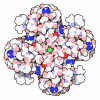





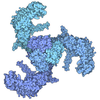
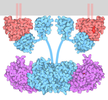

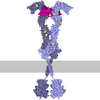


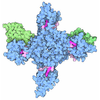
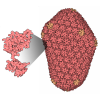


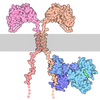
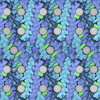
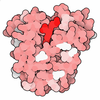

 Z (Sec.)
Z (Sec.) Y (Row.)
Y (Row.) X (Col.)
X (Col.)













































